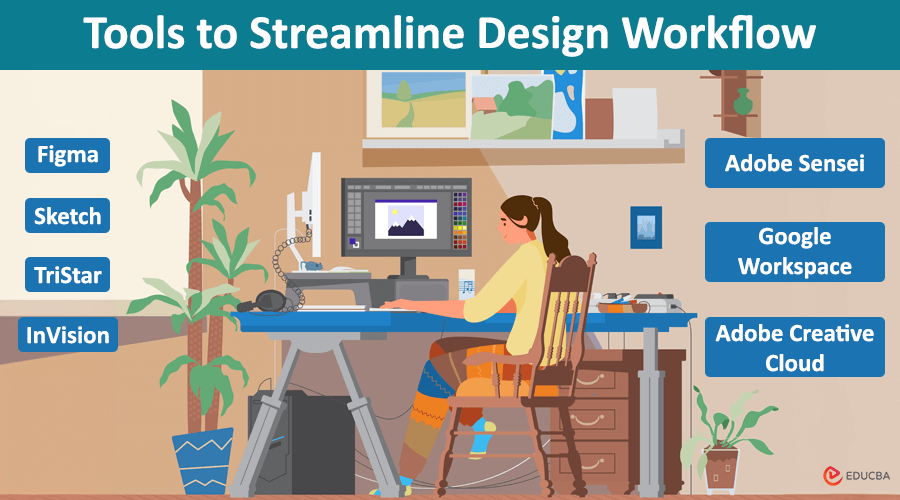
How to Streamline Design Workflow?
Streamlining design workflows means making each step of the design process faster and more efficient by organizing them to work smoothly and effectively. Using the right tools and methods, you can improve your work, speed up production, reduce mistakes, and free up more time for creativity. In this article, we will look at some key tools to streamline design workflow and ensure a smoother and more productive process from start to finish.
Here are some key tools to streamline design workflow and shape modern design practices:
#1. Advanced Prototyping Software
Advanced prototyping software transforms your design process into a more dynamic and interactive experience. Tools like Figma and Sketch offer real-time collaboration features, allowing you to work simultaneously with team members from anywhere in the world and keeping everyone engaged in the design process.
Benefits:
- Faster Feedback Cycles: Quickly iterate on designs without waiting days for revisions.
- Built-In UI Libraries: Save time by reusing components instead of starting from scratch.
#2. AI-Driven Design Assistants
AI-driven design assistants automate repetitive tasks, freeing more time for creative thinking. Tools like Adobe Sensei can suggest layout improvements or color schemes based on your project’s style.
Benefits:
- Quick Data Analysis: Spot patterns and insights that might take a human designer much longer to identify.
- Seamless Integration: Enhance functionality without disrupting established processes.
#3. Integrating CAD and CAM Systems Seamlessly
Integrating CAD and CAM systems simplifies the transition from digital designs to physical products. This seamless communication between design and manufacturing systems minimizes translation errors, saving time and reducing waste. Service providers like TriStar offer comprehensive design product development solutions tailored for manufacturing companies. Their expertise ensures precision throughout every stage of the process.
Benefits:
- Reduced Errors: Fewer translation errors between stages save time and reduce waste.
- Enhanced Collaboration: Designers and engineers can work on compatible platforms.
#4. Collaborative Cloud Platforms
Collaborative cloud platforms revolutionize the way design teams interact and work together. Tools like Google Workspace, Figma, and Adobe Creative Cloud allow designers to access and edit projects in real-time, regardless of location.
Benefits:
- Real-Time Collaboration: Various team members can collaborate on a project simultaneously.
- Improved Version Control: Automatic tracking of changes ensures clarity over the latest file version.
- Enhanced Communication: Built-in messaging tools ensure prompt feedback and organized discussions.
#5. Immersive VR/AR for Conceptual Visualization
Augmented Reality (AR) and Virtual Reality (VR) are now widely used in design, offering powerful new ways to visualize concepts. For example, an automotive designer can use VR to walk through a full-scale virtual car model before building it.
Benefits:
- Enhanced Visualization: Designers can explore and adjust 3D models in real time, gaining a better spatial understanding.
- Rapid Prototyping: Make quick adjustments to virtual prototypes without the cost of physical materials.
- Client Engagement: Clients can interact with the design, making their feedback more accurate and intuitive.
Integrating AR/VR into design workflows helps bridge the gap between imagination and reality, making each project stage—from concept to final product—more efficient and engaging.
#6. Real-Time Feedback Systems in Design Tools
Real-time feedback systems integrated into design tools give immediate insights as you work. This allows you to make adjustments instantly, speed up the iteration process, and boost productivity.
For example, tools like InVision offer live previews of designs with instant feedback from team members. This means designers no longer have to wait for scheduled reviews and can receive actionable input continuously. As a result, the workflow becomes more dynamic and responsive, keeping projects on track and moving forward efficiently.
#7. Workflow Automation Techniques
Workflow automation simplifies routine tasks, allowing designers to focus more on creative work. For instance, automating file organization and version updates can prevent manual tracking errors and save time.
Key Techniques:
- Task Scheduling: Automate repetitive tasks such as backups or software updates to maintain efficiency without manual intervention.
- Scripted Actions: Use scripts in tools like Photoshop to batch-process images, saving time on repetitive edits.
- Automated Reporting: Automatically generate progress reports to keep stakeholders informed with minimal effort.
- Integration with Project Management Tools: Sync design tools with platforms like Trello or Asana to streamline task management and enhance team coordination.
#8. Version Control in Creative Projects
Effective version control is crucial for keeping creative projects organized and error-free. By meticulously tracking changes, designers can easily revert to previous versions if needed.
Benefits:
- Organized Workflow: Platforms like GitHub or Abstract provide comprehensive version histories, allowing easy collaboration and tracking.
- Reduced Confusion: Minimize confusion and prevent the loss of critical work during revisions.
- Project Integrity: Ensure teams stay synchronized and maintain the project’s integrity throughout development.
#9. Cross-Disciplinary Team Coordination Strategies
Cross-disciplinary team coordination enhances collaboration among diverse skill sets, ensuring that teams such as designers, engineers, and marketers work together seamlessly to bring innovative products to market.
Key Strategies:
- Integrated Communication Platforms: Use tools like Slack or Microsoft Teams for real-time updates and clear communication.
- Regular Sync Meetings: Schedule frequent check-ins to align on project goals and milestones.
- Shared Documentation: Utilize cloud-based documents that all team members can access and update as needed.
- Role Clarity: Define roles clearly to prevent overlaps and ensure everyone understands their responsibilities.
These strategies help create a cohesive environment, reduce misunderstandings, and drive efficient progress toward shared goals.
Final Thoughts
The above tools streamline the design workflow and make each step more efficient and productive. This approach reduces errors, saves time, and enhances collaboration, creativity, and innovation. Embracing these strategies will ensure smoother project execution and higher quality outcomes, helping you stay ahead in the competitive design landscape.
Recommended Articles
We hope you found these tools for streamlining design workflows helpful. Check out these articles to learn more about optimizing your design process and boosting your productivity.
